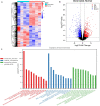Ficus carica L. Attenuates Denervated Skeletal Muscle Atrophy via PPARα/NF-κB Pathway
- PMID: 33343385
- PMCID: PMC7744683
- DOI: 10.3389/fphys.2020.580223
Ficus carica L. Attenuates Denervated Skeletal Muscle Atrophy via PPARα/NF-κB Pathway
Abstract
Treatment options for denervated skeletal muscle atrophy are limited, in part because the underlying molecular mechanisms are not well understood. Unlike previous transcriptomics studies conducted in rodent models of peripheral nerve injury, in the present study, we performed high-throughput sequencing with denervated atrophic biceps muscle and normal (non-denervated) sternocleidomastoid muscle samples obtained from four brachial plexus injury (BPI) patients. We also investigated whether Ficus carica L. (FCL.) extract can suppress denervated muscle atrophy in a mouse model, along with the mechanism of action. We identified 1471 genes that were differentially expressed between clinical specimens of atrophic and normal muscle, including 771 that were downregulated and 700 that were upregulated. Gene Ontology (GO) and Kyoto Encyclopedia of Genes and Genomes (KEGG) pathway analyses revealed that the differentially expressed genes were mainly enriched in the GO terms "structural constituent of muscle," "Z disc," "M band," and "striated muscle contraction," as well as "Cell adhesion molecules," "Glycolysis/Gluconeogenesis," "Peroxisome proliferator-activated receptor alpha (PPARα) signaling pathway," and "P53 signaling pathway." In experiments using mice, the reduction in wet weight and myofiber diameter in denervated muscle was improved by FCL. extract compared to saline administration, which was accompanied by downregulation of the proinflammatory cytokines interleukin (IL)-1β and IL-6. Moreover, although both denervated groups showed increased nuclear factor (NF)-κB activation and PPARα expression, the degree of NF-κB activation was lower while PPARα and inhibitor of NF-κB IκBα expression was higher in FCL. extract-treated mice. Thus, FCL. extract suppresses denervation-induced inflammation and attenuates muscle atrophy by enhancing PPARα expression and inhibiting NF-κB activation. These findings suggest that FCL. extract has therapeutic potential for preventing denervation-induced muscle atrophy caused by peripheral nerve injury or disease.
Keywords: Ficus carica; NF-κß; PPAR; denervated muscle atrophy; muscle atrophy; peripheral nerve injury.
Copyright © 2020 Dai, Xiang, Fu, Xu, Jiang and Xu.
Conflict of interest statement
The authors declare that the research was conducted in the absence of any commercial or financial relationships that could be construed as a potential conflict of interest.
Figures







Similar articles
-
Targeted ablation of the cellular inhibitor of apoptosis 1 (cIAP1) attenuates denervation-induced skeletal muscle atrophy.Skelet Muscle. 2019 May 24;9(1):13. doi: 10.1186/s13395-019-0201-6. Skelet Muscle. 2019. PMID: 31126323 Free PMC article.
-
PHD3 mediates denervation skeletal muscle atrophy through Nf-κB signal pathway.FASEB J. 2021 Apr;35(4):e21444. doi: 10.1096/fj.202002049R. FASEB J. 2021. PMID: 33749901
-
Transcriptome sequencing and analysis reveals the molecular mechanism of skeletal muscle atrophy induced by denervation.Ann Transl Med. 2021 Apr;9(8):697. doi: 10.21037/atm-21-1230. Ann Transl Med. 2021. PMID: 33987395 Free PMC article.
-
Identification of potential microRNAs and KEGG pathways in denervation muscle atrophy based on meta-analysis.Sci Rep. 2021 Jun 30;11(1):13560. doi: 10.1038/s41598-021-92489-1. Sci Rep. 2021. PMID: 34193880 Free PMC article.
-
[Progress in research on the mechanism of denervated skeletal muscle atrophy].Zhongguo Xiu Fu Chong Jian Wai Ke Za Zhi. 2008 Dec;22(12):1511-4. Zhongguo Xiu Fu Chong Jian Wai Ke Za Zhi. 2008. PMID: 19137902 Review. Chinese.
Cited by
-
ROS-activated CXCR2+ neutrophils recruited by CXCL1 delay denervated skeletal muscle atrophy and undergo P53-mediated apoptosis.Exp Mol Med. 2022 Jul;54(7):1011-1023. doi: 10.1038/s12276-022-00805-0. Epub 2022 Jul 21. Exp Mol Med. 2022. PMID: 35864308 Free PMC article.
-
Ablation of NLRP3 inflammasome attenuates muscle atrophy via inhibiting pyroptosis, proteolysis and apoptosis following denervation.Theranostics. 2023 Jan 1;13(1):374-390. doi: 10.7150/thno.74831. eCollection 2023. Theranostics. 2023. PMID: 36593964 Free PMC article.
-
Plant-Derived Treatments for Different Types of Muscle Atrophy.Phytother Res. 2025 Feb;39(2):1107-1138. doi: 10.1002/ptr.8420. Epub 2025 Jan 2. Phytother Res. 2025. PMID: 39743857 Free PMC article. Review.
-
Ficus carica L. (Fig) promotes nerve regeneration in a mouse model of sciatic nerve crush.FEBS Open Bio. 2024 Aug;14(8):1356-1364. doi: 10.1002/2211-5463.13859. Epub 2024 Jun 28. FEBS Open Bio. 2024. PMID: 38942739 Free PMC article.
-
Inflammation: Roles in Skeletal Muscle Atrophy.Antioxidants (Basel). 2022 Aug 29;11(9):1686. doi: 10.3390/antiox11091686. Antioxidants (Basel). 2022. PMID: 36139760 Free PMC article. Review.
References
LinkOut - more resources
Full Text Sources
Research Materials
Miscellaneous

